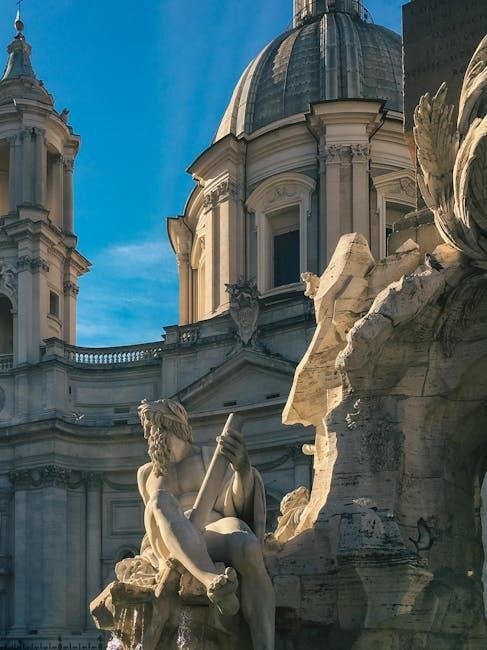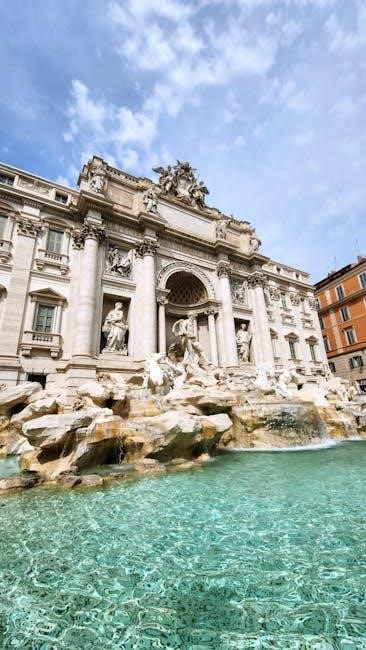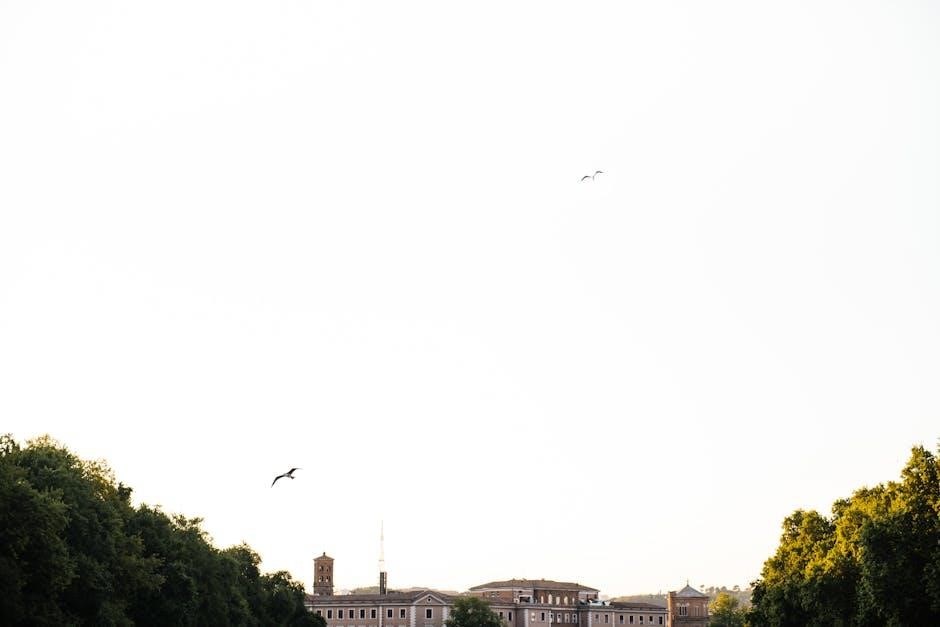
Rome, the Eternal City, offers a wealth of historical, cultural, and artistic treasures. A 3-day itinerary provides an ideal framework to explore its iconic landmarks like the Colosseum and Vatican, ensuring a memorable and structured experience. With practical tips and a downloadable PDF guide, you can navigate the city seamlessly, making the most of your time in this breathtaking destination.
1.1. Overview of Rome’s Historical and Cultural Significance
Rome, the Eternal City, is a treasure trove of ancient history, art, and architecture. From the Colosseum to the Roman Forum, its ruins reflect the grandeur of the Roman Empire. The Vatican, with its Sistine Chapel and St. Peter’s Basilica, showcases Renaissance masterpieces. Rome’s cultural significance is unparalleled, blending religious, political, and artistic heritage. Its vibrant streets, adorned with Baroque fountains and piazzas, offer a glimpse into its enduring influence on global culture. Exploring Rome is a journey through centuries of human achievement and creativity.
1.2. Benefits of a Structured 3-Day Plan
A structured 3-day itinerary ensures you maximize your time in Rome, covering its iconic landmarks and hidden gems efficiently. It helps you avoid missing key attractions, manage time effectively, and reduce stress. A well-planned schedule allows you to explore without feeling rushed, balancing sightseeing with relaxation. Additionally, it aids in budgeting and organizing transportation, ensuring a seamless experience. With a clear plan, you can focus on enjoying the city’s history, art, and culture, creating lasting memories of your Roman adventure.

Day 1: Ancient Rome and the Colosseum
Dedicate your first day to Ancient Rome’s iconic landmarks. Start with the Colosseum and Roman Forum, then explore Palatine Hill. Conclude with a traditional Italian dinner nearby.
2.1. Morning: Colosseum and Roman Forum Tour
2.2. Afternoon: Explore Palatine Hill and Arch of Constantine
After visiting the Colosseum, head to Palatine Hill, the legendary birthplace of Rome. Wander through its ancient ruins, including the Palace of Domitian and the Hut of Romulus. Take in panoramic views of the Roman Forum and Circus Maximus. Nearby, admire the Arch of Constantine, a triumphal arch celebrating Constantine’s victory. Use your Roma Pass for entry, and consider a leisurely stroll to absorb the historical ambiance. Wear comfortable shoes, as the terrain can be uneven. This afternoon offers a deep connection to Rome’s imperial past and architectural grandeur.
2.3. Evening: Dinner Near the Colosseum
Conclude your day with a memorable dinner near the Colosseum. Choose a trattoria offering authentic Roman cuisine, such as carbonara or amatriciana. For a special experience, dine at Aroma Restaurant, located on Palazzo Manfredi, which offers stunning views of the Colosseum. Reservations are recommended for popular spots. Savor local wines and gelato for dessert. This evening provides a perfect blend of relaxation and immersion in Rome’s culinary traditions after a day of exploration.

Day 2: Vatican City and Renaissance Rome
Dedicate your second day to Vatican City’s iconic landmarks, including the Vatican Museums and Sistine Chapel. Explore St. Peter’s Basilica and enjoy the afternoon discovering Piazza Navona and the Pantheon.
3.1. Morning: Vatican Museums and Sistine Chapel
Begin your day with a visit to the Vatican Museums, home to some of the world’s most renowned art. Marvel at Michelangelo’s stunning Sistine Chapel ceiling and explore galleries filled with masterpieces. The museums showcase centuries of artistic and historical treasures, including works by Raphael and Caravaggio. Consider booking a guided tour for deeper insights. Arrive early to avoid crowds and make the most of your morning in this iconic cultural hub.
3.2. Mid-Morning: Visit St. Peter’s Basilica
After exploring the Vatican Museums, head to St. Peter’s Basilica, the largest church in the world. Admire Michelangelo’s exquisite Pieta and the stunning dome he designed. The basilica, built over St; Peter’s tomb, is a masterpiece of Renaissance architecture. Consider climbing to the dome’s summit for breathtaking views of Rome. Booking tickets in advance is recommended to avoid long queues. The grandeur and spiritual significance of this site make it a must-visit during your Vatican City tour.
3.3. Afternoon: Piazza Navona and Pantheon
Spend your afternoon exploring Piazza Navona, a charming Baroque square adorned with ornate fountains and vibrant street performers. Its elegant architecture and lively atmosphere make it a perfect spot for relaxation. Nearby, visit the Pantheon, an ancient Roman temple renowned for its impressive dome and oculus. This architectural marvel offers a glimpse into Rome’s rich history. Both sites are within walking distance, allowing for a seamless afternoon of cultural immersion and enjoyment.
3.4. Evening: Relax at Piazza del Popolo
Conclude your day with a serene evening at Piazza del Popolo, one of Rome’s most iconic squares. Admire the Twin Churches and the ancient Egyptian obelisk, surrounded by street performers and lively crowds. The square transforms into a magical spot at dusk, with golden lighting illuminating its landmarks. Enjoy a leisurely stroll, savor gelato from a local shop, or relax at a nearby café. It’s the perfect way to unwind and soak in Rome’s vibrant atmosphere before heading back to your accommodation.
Day 3: Modern Rome and Hidden Gems
Explore Rome’s modern charm and lesser-known treasures. Visit Trevi Fountain, Spanish Steps, and Borghese Gallery, then discover Trastevere’s bohemian vibe and authentic trattorias for a unique experience.
4.1. Morning: Explore the Trevi Fountain and Spanish Steps
Start your day at the iconic Trevi Fountain, where legend says tossing a coin ensures your return to Rome. Admire the baroque masterpiece and its vibrant atmosphere. Stroll to the Spanish Steps, one of Rome’s most famous landmarks, perfect for photos and people-watching. Visit early to avoid crowds and enjoy a peaceful morning. Nearby, explore the elegant Piazza di Spagna and its upscale shops. Grab a coffee at a local café to fuel your day before heading to your next destination.
4.2. Mid-Morning: Visit the Borghese Gallery
Head to the Galleria Borghese, a museum housing an extraordinary collection of Renaissance and Baroque art. Marvel at masterpieces by Bernini, Caravaggio, and Titian, all set within the stunning Villa Borghese. The gallery’s elegant design and world-class art make it a must-visit. Be sure to book tickets in advance as entry is timed and limited. After exploring, take a leisurely stroll through the Villa Borghese gardens, a serene oasis in the heart of the city, perfect for relaxation before continuing your day.
4.3. Afternoon: Wander Through Trastevere Neighborhood
Spend the afternoon exploring Trastevere, a charming neighborhood known for its narrow cobblestone streets, historic churches, and vibrant atmosphere. Visit the iconic Santa Maria in Trastevere, one of Rome’s oldest churches, and enjoy the lively piazza. Take your time to get lost in the winding streets, stopping for a coffee or gelato at a local café. This bohemian enclave is perfect for soaking in Rome’s authentic charm and discovering hidden gems. Don’t forget to explore the boutique shops and trattorias that make Trastevere a must-visit destination. Return in the evening for its renowned nightlife.
4.4. Evening: Farewell Dinner at a Local Trattoria
Conclude your Roman adventure with a memorable farewell dinner at a traditional trattoria. Savor authentic Italian cuisine, including pasta dishes, pizza, and gelato. Pair your meal with a glass of local wine for a true Italian experience. Many trattorias offer cozy outdoor seating, allowing you to soak in the evening atmosphere. Don’t forget to make reservations in advance, especially for popular spots. This final dinner is the perfect way to celebrate your time in Rome and leave with lasting memories of this incredible city. Buon appetito!

Practical Tips for Your 3-Day Rome Itinerary
Plan ahead by booking tickets and reservations in advance. Use the Roma Pass for public transport and attraction discounts. Pack light, stay hydrated, and enjoy the journey!
5.1. Best Times to Visit Major Attractions
Visit the Colosseum and Roman Forum early in the morning to avoid crowds. The Vatican Museums are less busy on weekdays, while St. Peter’s Basilica is ideal in the late afternoon. Piazza Navona and the Pantheon shine during mid-morning, offering serene atmospheres. For a magical experience, explore the Trevi Fountain in the evening when it’s illuminated. Avoid peak tourist hours (11 AM–3 PM) for a smoother experience. Booking tickets in advance ensures skip-the-line access to popular sites like the Vatican and Colosseum.
5.2. Essential Items to Pack
- Comfortable shoes for walking Rome’s cobblestone streets.
- Lightweight clothing for warm days and layers for cooler evenings.
- Roma Pass for discounts and skip-the-line access to attractions.
- Reusable water bottle to stay hydrated while exploring.
- Travel-sized essentials like sunscreen and a portable charger.
- Power adapter for charging devices (Italy uses Type L plugs).
- Travel documents including tickets, hotel reservations, and ID.
- Small backpack for carrying daily necessities.
- Guidebook or map to navigate the city effortlessly.
- Medications and first-aid kit for emergencies.
5.3. How to Use Public Transport in Rome
Rome’s public transport system is efficient and convenient. The Metro, buses, and trams connect major attractions. Purchase tickets at kiosks or online, and validate them before boarding. A Roma Pass offers discounts and skip-the-line access. Metro line B is ideal for reaching the Colosseum. Plan routes using the official ATAC app for real-time updates. Tickets are valid for 100 minutes across all transport modes, making it easy to explore the city stress-free.

Downloadable Rome 3-Day Itinerary PDF
Download a customizable Rome 3-day itinerary in PDF format, complete with maps, tips, and schedules. Perfect for easy planning and ensuring a stress-free Roman adventure.
6.1. How to Create a Customizable PDF
To create a customizable Rome 3-day itinerary PDF, start by selecting a template that fits your travel style. Use online tools to edit sections, adding personal preferences like hotel bookings, dining reservations, and must-visit attractions. Include maps, opening hours, and ticket information for seamless navigation. Export the final version for easy access on your device. This format allows flexibility, ensuring your trip is tailored to your interests while maintaining a structured plan.
6.2. Benefits of a Printable Itinerary
A printable Rome 3-day itinerary offers convenience and clarity, allowing you to plan and organize your trip effectively. It provides a clear timeline, ensuring you maximize your time without missing key attractions. The PDF format is easy to share with travel companions and access offline, eliminating reliance on internet connectivity. Printed copies are ideal for quick references while exploring the city. This tool enhances your travel experience by keeping everything structured and accessible, making your Roman adventure stress-free and enjoyable.